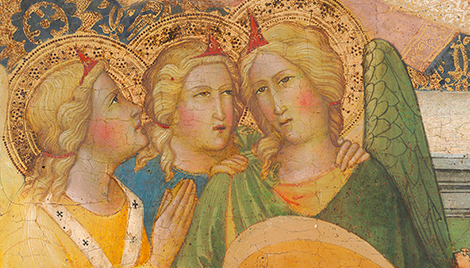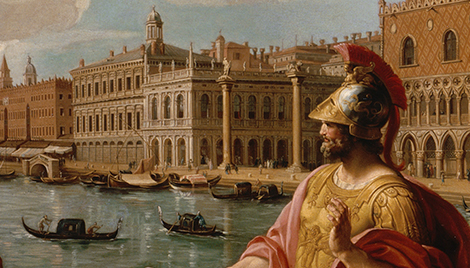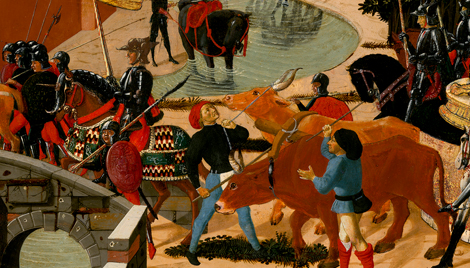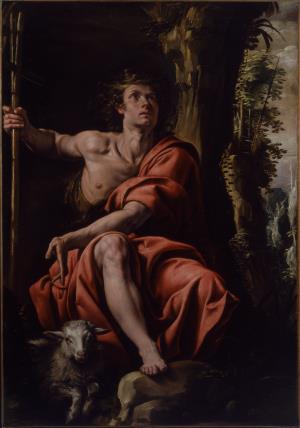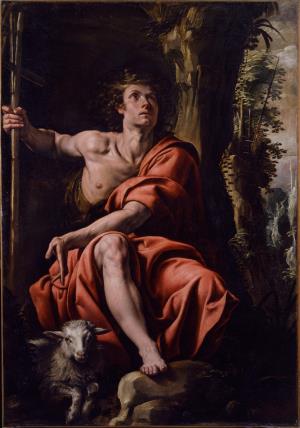Saint John the Baptist in the Wilderness
Saint John the Baptist in the Wilderness
- Artist
- Tanzio da Varallo
- Artist Dates
- c. 1575-1633
- Artist Nationality
- Italian
- Title
- Saint John the Baptist in the Wilderness
- Date
- c. 1627-29
- Medium
- oil on canvas
- Dimensions
- 165.1 x 113.98 cm (65 x 44-7/8 in)
- K Number
- K1223
- Repository
- Philbrook Museum of Art
- Accession Number
- 1944.2
- Notes
Provenance
Enrico Marinucci, Rome; [1] probably sold 1936/1937 to (Count Alessandro Contini Bonacossi [1878-1955] Rome-Florence); sold to Samuel H. Kress [1863-1955] on 1 September 1939; gift 1944 to Philbrook Museum of Art, Tulsa, no. 1944.2. [1] This is probably the painting listed as by Dosso Dossi in a letter dated 1 October 1936 from an Enrico Cappiello, offering pictures on behalf of Marinucci to the director of the Wiliam Rockhill Nelson Gallery (Philbrook Museum of Art, Tulsa, curatorial file for Tanzio da Varallo, 1944.2). It is likely that those paintings came from the collecion of Marinucci's uncle, Cardinal Pietro Gasparri [1852-1934].
Catalogue Entry
Tanzio da Varallo
Saint John the Baptist in the Wilderness
K1223
Tulsa, Okla., Philbrook Art Center (374), since 1953.(1) Canvas. 63 3/4 x 43 3/4 in. (162 x 111.1 cm.). Good condition; cleaned 1960. Since K1223 first came to notice, some thirty years ago, with an attribution to Velazquez, it has been unanimously accepted as an important painting by Tanzio da Varallo.(2) Similarity of the saint to an angel at the upper left in Tanzio's altarpiece of about 1615, the Madonna in Glory in the Collegiata, Pescocostanzo, has suggested an equally early dating for K1223.(3) The similarity of pose and drapery of the lower parts of the two bodies is indeed striking, but while the forms in the altarpiece are relaxed and quiet, those in K1223 are tense and agitated. This is the mannered, yet very serious, realistic, and forceful style which is now customarily dated about 1625 in Tanzio's career.' As in K348 (Fig. 146), the execution here is remarkably sure and precise. X-rays have shown no alteration of details, and the preservation is remarkably good. Provenance: Cav. Enrico Marinucci, Rome. Contini Bonacossi, Florence. Kress acquisition, 1939 –exhibited: Texas Centennial Museum, College of Mines and Metallurgy, El Paso, Tex., Dec. 7, 1940-Jan. 1, 1941, as Tanzio; Philbrook Art Center, Tulsa, Okla., July 1943; after entering the Philbrook Art Center: 'Tanzio da Varallo,' Palazzo Madama, Turin, Oct. 30, 1959-Jan. 31, 1960, no. 13 of catalogue by G. Testori, as Tanzio; 'Art Treasures for America,' National Gallery of Art, Washington, D.C., Dec. 10, 1961-Feb. 4, 1962, no. 91, as Tanzio; 'Art in Italy, 1600-1700,' Detroit Institute of Arts, Detroit, Mich., Apr. 6-May 9, 1965, no. 140, catalogue note by F. Cummings, as Tanzio; 'The Italian Heritage,' Wildenstein's, New York, May 17-Aug. 29, 1967, no. 34, as Tanzio.
References
(1) Catalogue by W. E. Suida, 1953, p. 62, as Tanzio. (2) K1223 has been attributed to Tanzio by G. Fiocco, F. M. Perkins, A. Venturi (in ms. opinions), R. Longhi (in Proporzioni, vol. I, 1943, p. 53 n. 66, repeating his earlier ms. opinion), G. Testori (loc. cit. in Provenance), M. Rosci (in Burlington Magazine, vol. CII, 1960, p. 32), and F. Cummings (loc. cit. in Provenance). (3) W. E. Suida, loco cit. in note 1, above. (4) See F. Cummings, loco cit. in Provenance. F. H. Dowley (in Art Quarterly, vol. XXVII, 1964, p. 523), writing of the Detroit exhibition (see Provenance), cites K1223 as an example of the remarkable efflorescence of Mannerism in Lombardy at the beginning of the seventeenth century, a kind of Mannerism which took notice, at the same time, of Caravaggio's realism.

